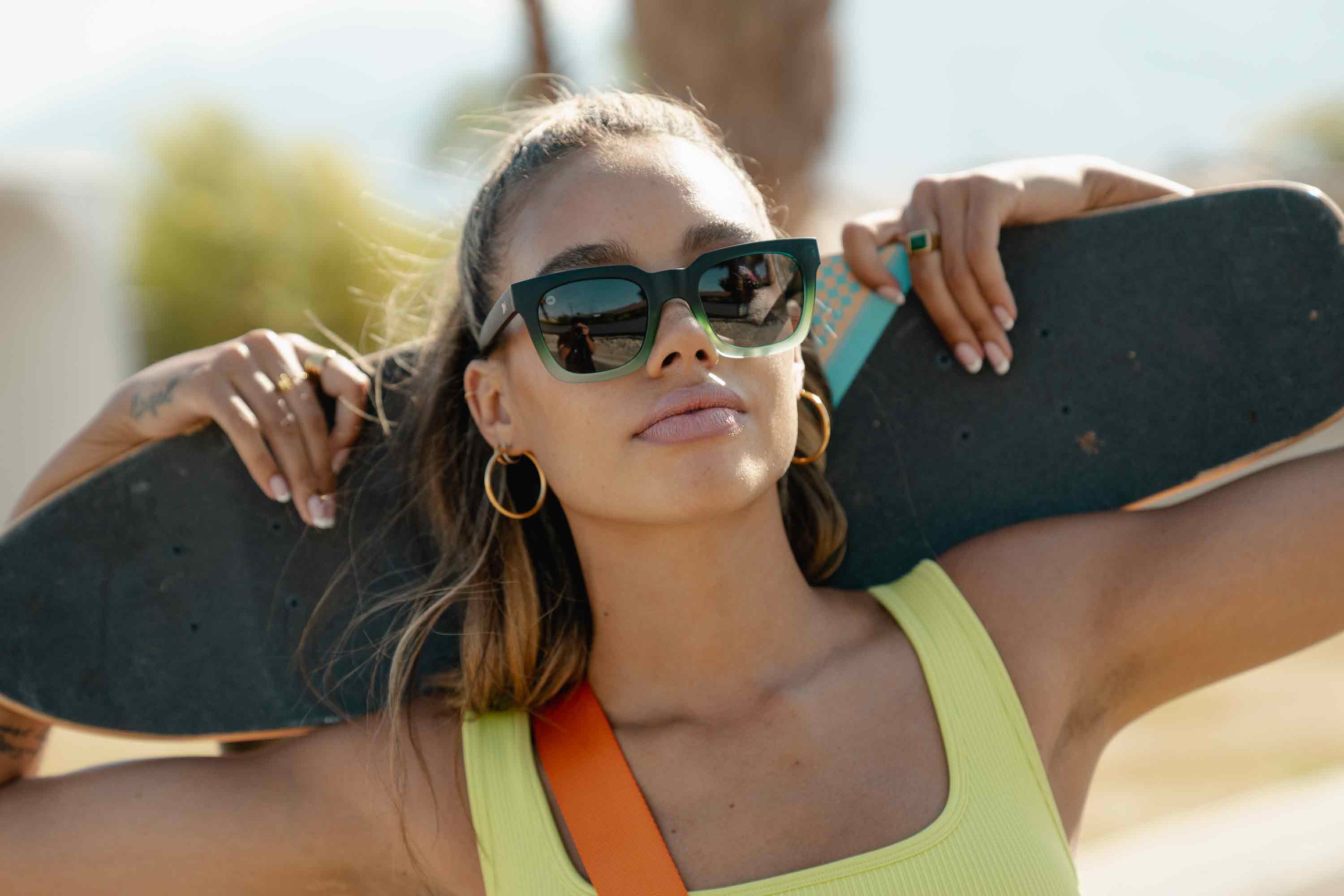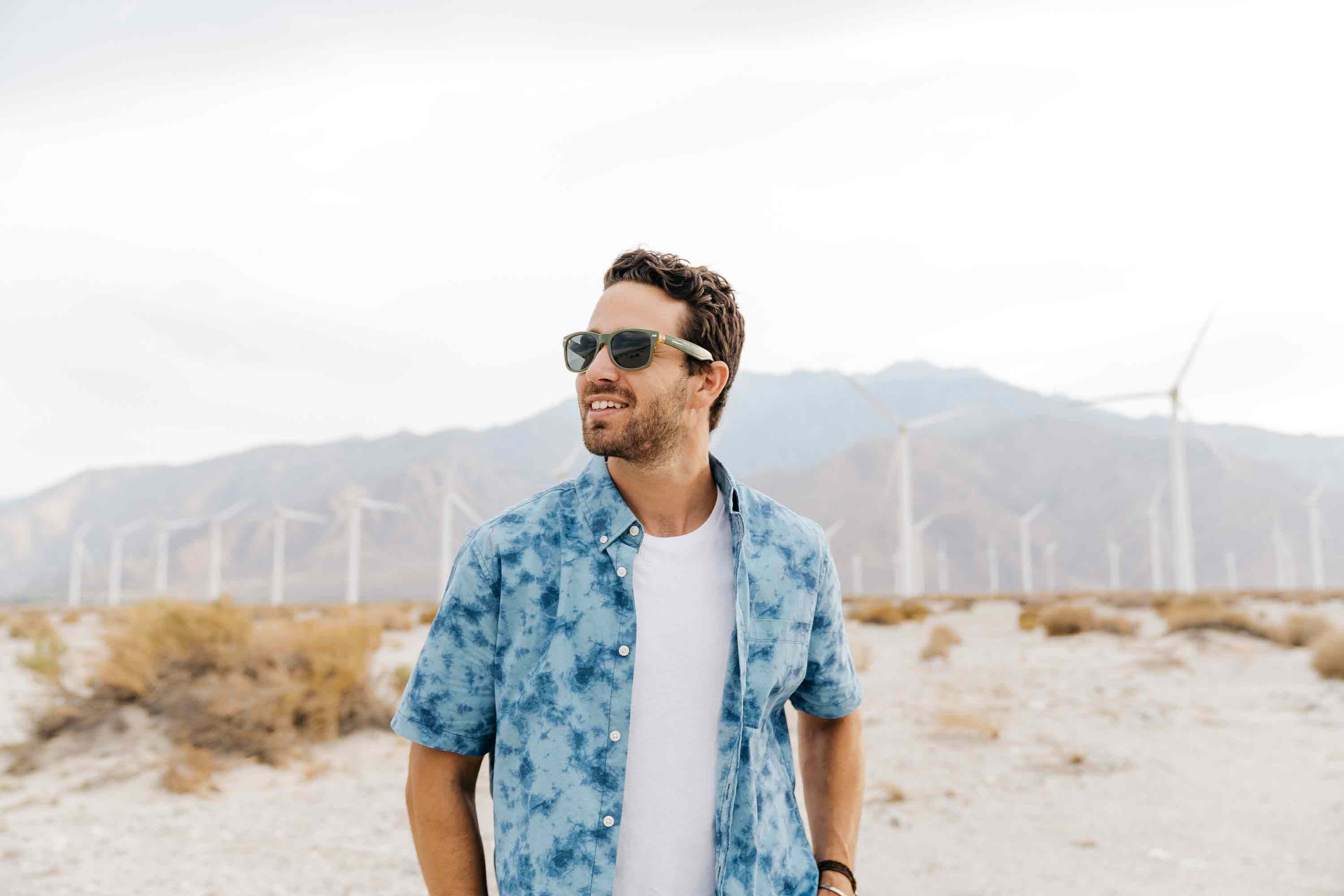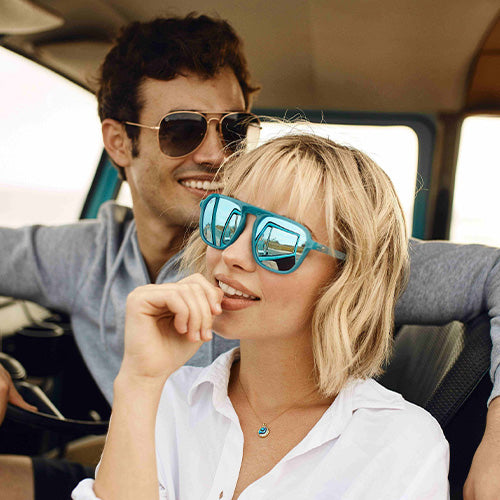What comes to mind when you think of blue-light-blocking glasses? Many picture the glasses with tinted lenses people wear while using digital devices, which have grown increasingly popular in recent years. But can sunglasses block blue light? The answer may surprise you.
BLUE LIGHT FROM THE SUN
People often use blue-light blockers to protect their eyes from the light that LEDs and electronic devices emit. And these blue-light-blocking glasses can be effective in filtering artificial light of all kinds. But most of the blue light we encounter isn’t man made; the sun is the greatest producer of blue light.
So do we have to give up protection from blue light if we want to slip on a pair of shades and head outside? Not at all! Sunglasses with polycarbonate lenses, which Knockarounds have, are highly effective in blocking the strongest type of blue light.

THE TWO TYPES OF BLUE LIGHT
Blue light has different types? Yes. As a whole, blue light is light that is on the visible light spectrum, which is measured in nanometers (nm). Blue light has a wavelength between 400 and 495 nanometers. Blue light within that nanometer range is divided into two categories: “high-energy visible blue-violet light” and lower-energy “circadian rhythm blue-turquoise light.”
The first, violet, is on the low end of the spectrum, between 400 and 450 nm. This blue light has shorter wavelengths and higher energy. The sun is the main producer of this high-energy blue light. The second, turquoise, is on the other end of the spectrum and has lower levels of energy. Electronic devices are the most common sources of this lower-energy blue light.
THE EFFECTS OF BLUE LIGHT FROM THE SUN
As you may suspect, higher-energy blue light poses more risk to our eyes than lower-energy blue light. A study by researchers at the University of Manchester and the Erasmus Medical Center in the Netherlands found that high-energy blue light exposure causes photochemical reactions in the cornea, the lens, and the retina of the eye. And this exposure can temporarily or permanently damage parts of the eye. The retina is especially susceptible to damage from blue light.
The study concluded that “long-term exposure to blue light with short wavelengths [and higher energy] may alter the ocular surface by three main mechanisms: oxidative stress damage, ocular surface inflammation, and cell apoptosis [cell death].”

SUNGLASSES AS BLUE LIGHT BLOCKERS
So how well do sunglasses block this potentially harmful blue light? Researchers at the University of Texas Medical Branch conducted a study to answer that question. They tested over two dozen commercially available sunglasses with polycarbonate lenses to see how much blue light they blocked. The results? While the effectiveness of blocking blue light varied across different sunglasses types, sunglasses did block a significant amount of high-energy blue light.
Researchers divided over two dozen test sunglasses into three groups: low price (up to $3.31), medium price ($10 to $40), and high price ($200 to $350). If you’re guessing that more expensive sunglasses have more blue-light blocking power, you’re wrong; the top performers in the study were medium-priced sunglasses. In some cases, low-cost sunglasses outperformed high-cost sunglasses in their ability to filter out blue light.
The study presents its results in these three price groupings. In the low-priced group, five sunglasses were tested. These blocked an average of 72.5% of blue light in the high-energy category. In the second group, with medium prices, four different sunglasses were tested. These performed the best of the three price ranges, with varying results within that group. One medium-priced pair the research team tested blocked 62.8% of high-energy violet blue light. One blocked 82.5%, while another in the medium price range blocked 94.4% of high-energy blue light.
On average, the expensive designer glasses tested didn’t perform as well as their medium-priced counterparts. While one of the five expensive pairs that were used in the study blocked about 94% of high-energy blue light, others lagged considerably behind. One high-end brand blocked just 57.4% of high-energy blue light, while the others in the high-cost group performed in the mid-70% range.
UNDERSTANDING THE SUN’S BLUE LIGHT
Researchers at the University of South China considered the effect blue light from the sun has on the eyes. Their study notes that short-wave blue light with wavelengths between 415 nm and 455 nm can cause eye damage. According to the study, high-energy blue light “passes through the cornea and lens to the retina, causing diseases such as dry eye, cataract, [and] age-related macular degeneration.”
The study points out that “sunlight exposure is considered to be a risk factor for cataracts,” and that “sunlight is much richer in short-wavelength [blue] light than most artificial illuminants.” The researchers also note that “as the harmful effects of blue light are gradually realized by the public, eye discomfort related to blue light is becoming a more prevalent concern.”

THE DANGERS OF BLUE LIGHT BY LOCATION
The amount of blue light the eye takes in isn’t the same everywhere. Researchers at Spain’s University of Málaga note that “blue light account[s] for 25% of the sun’s rays.” But how much of that 25% you’re exposed to depends on several factors. These sun-related factors include the time of year, the time of day, and the latitude of the location, all of which determine the angle of the sun in any given spot on the planet.
When the sun is strongest, so too is the amount of blue light that a person may take in. In the early morning and late afternoon, the sun’s rays pass through the atmosphere at a greater angle; less sunlight reaches the Earth and the people on it. In the northern hemisphere, the sun’s angle is lower in winter and higher in summer. That’s why it’s sunnier in the summer. All year, the sun is strongest during each two-hour period before and after solar noon.
Ground conditions also play a role. In places where ground reflection is high, such as in snow, at the beach, or out on the ocean, the amount of natural blue light that reaches the eye will also be higher.
SUN PROTECTION GLASSES FOR EVERY SITUATION
If you’re headed to the beach, there may be no better shades than those from the Beach Peach line. With joyful hues that capture summer fun, there’s a reason these shades come with the motto “Life’s a Peach!” If you’re going for a traditional look that’s never boring, consider a pair of Beach Peach Classics. With an understated arched top and subtly rounded lenses, these versatile unisex sunglasses look good on everyone.
For a bold and modern look with a nod to vintage style, slip on a pair of Beach Peach Pacific Palisades. Named for an idyllic spot on the California coast, these sunglasses have rounded rectangular lenses that are topped with a retro bar, giving them a laid-back feel that epitomizes an easy beach lifestyle. If fashion-forward is what you’re after, check out a pair of Beach Peach Seventy Nines. These summer-ready shades offer timeless style, getting noticed without ever needing to call attention to themselves.
For getting out on the ocean, you can’t go wrong with sporty rubberized shades. With polarized Caribbean moonshine lenses and a deep blue hue that captures Pacific waters, Navy/Mint Premiums Sport sunglasses were made for adventures on the open water. As for durability? They’ve got FDA approved impact resistant lenses and rubberized frames that can take whatever the ocean dishes out. Plus rubber nose pads to keep your sunglasses secure!

To capture the essence of the ocean with a more subtle style, slip on a pair of Black Ocean Premiums. With glossy black frames and polarized smoke lenses, these sleek shades look great out at sea or on land—just about anywhere you want to present cool summer vibes with sophistication that’s never stuffy.
Heading out to do some fishing? We’ve got you covered with our selection of fishing sunglasses! With polarized lenses that cut down on harsh light that reflects from the water’s surface, these shades are perfect for keeping your eyes on the big prize of a great catch. From piloting a boat to spotting fish beneath the water’s surface, polarized sunglasses can make all the difference.
For snowy conditions, polarized lenses are also a good choice. One of our bestsellers for snowboarding and skiing, Rooftop Mile Highs bring classic aviation style to the slopes. A brown-to-cream fade frame that’s made from recycled metal perfectly complements polarized impact-resistant sky-blue lenses, offering full UV400 protection. For more action-forward outings, look to our popular snow goggles. With a choice of two frame styles, Slingshots and Flybys, these goggles offer colorful style, long-lasting durability, and, as always, Knockaround’s signature value. High quality doesn’t have to come at a high price!
To offset the effects of blue light from electronic devices, you can go with blue light blockers. But you can also get blue-light glasses benefits with protective sunglasses. Either way, we’ve got the best sunglasses for eye protection you can find at affordable prices.
Written by William McCleary for Knockaround.






Are Blue Light Glasses Bad For Your Eyes?
Why Are Sunglasses So Expensive?